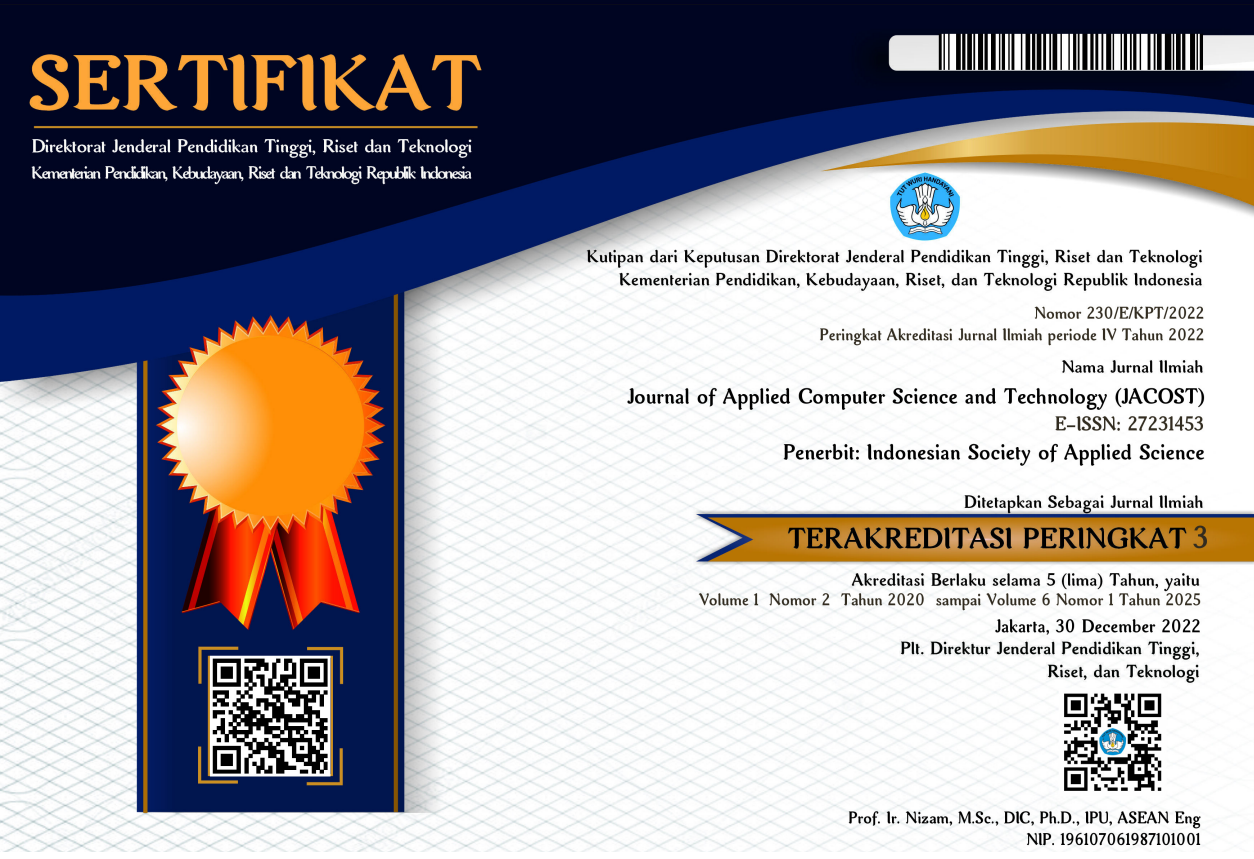Model Penentuan Rute Terpendek Penjemputan Sampah Menggunakan Metode MTSP dan Algoritma Genetika
DOI:
https://doi.org/10.52158/jacost.v2i1.168Keywords:
genetic algorithm, multiple traveling salesman problem, shortest route, traveling salesman problemAbstract
Garbage pick-ups performed by two or more people must have a route in their pickup. However, it is not easy to model the route of the pickup that each point must be passed and each point is only passed once. Now, the method to create a route has been done a lot, one of the most commonly used methods is the creation of routes using the Traveling Salesman Problem method. Traveling Salesman Problem is a method to determine the route of a series of cities where each city is only traversed once. In this study, the shortest route modeling was conducted using Multiple Traveling Salesman Problem and Genetic Algorithm to find out the shortest route model that can be passed in garbage pickup. In this study, datasets will be used as pick-up points to then be programmed to model the shortest routes that can be traveled. The application of Multiple Traveling Salesman Problem method using Genetic Algorithm shows success to model garbage pickup route based on existing dataset, by setting the parameters of 100 generations and 100 population and 4 salesmen obtained 90% of the best individual opportunities obtained with the best individual fitness value of 0.05209. The test was conducted using BlackBox testing and the results of this test that the functionality on the system is 100% appropriate.
Downloads
References
X. Chen, P. Zhang, G. Du, and F. Li, “Ant Colony Optimization Based Memetic Algorithm to Solve Bi-Objective Multiple Traveling Salesmen Problem for Multi-Robot Systems,” IEEE Access, vol. 6, no. c, pp. 21745–21757, 2018, doi: 10.1109/ACCESS.2018.2828499.
J. Xu, L. Pei, and R. Z. Zhu, “Application of a genetic algorithm with random crossover and dynamic mutation on the travelling salesman problem,” Procedia Comput. Sci., vol. 131, pp. 937–945, 2018, doi: 10.1016/j.procs.2018.04.230.
Z. Xing and S. Tu, “A Graph Neural Network Assisted Monte Carlo Tree Search Approach to Traveling Salesman Problem,” IEEE Access, vol. 8, pp. 108418–108428, 2020, doi: 10.1109/ACCESS.2020.3000236.
D. D’Ambrosio, W. Spataro, R. Rongo, and G. G. R. Iovine, Genetic Algorithms, Optimization, and Evolutionary Modeling, vol. 2. Elsevier Ltd., 2013.
V. Singh and S. Choudhary, “Genetic Algorithm for Traveling Salesman Problem : Using Modified Partially-Mapped Crossover Operator,” pp. 20–23, 2009.
A. Hussain, Y. S. Muhammad, M. N. Sajid, I. Hussain, A. M. Shoukry, and S. Gani, “Genetic Algorithm for Traveling Salesman Problem with Modified Cycle Crossover Operator,” vol. 2017, pp. 1–8, 2017.
I. Sugiarto Cokrowibowo, Ismail, “Multiple Traveling Salesman Problem Menggunakan Algoritma Ant Colony Optimization dengan Operasi Elitism,” Univ. Sulawesi Barat, vol. 1, no. 2, p. 11, 2019, doi: 10.31605/jcis.v2i1.
X. Dong and Y. Cai, “A novel genetic algorithm for large scale colored balanced traveling salesman problem,” Futur. Gener. Comput. Syst., vol. 95, pp. 727–742, 2019, doi: 10.1016/j.future.2018.12.065.
T. Öncan, I. K. Altinel, and G. Laporte, “A comparative analysis of several asymmetric traveling salesman problem formulations,” Comput. Oper. Res., vol. 36, no. 3, pp. 637–654, 2009, doi: 10.1016/j.cor.2007.11.008.
M. A. H. Akhand, S. I. Ayon, S. A. Shahriyar, N. Siddique, and H. Adeli, “Discrete Spider Monkey Optimization for Travelling Salesman Problem,” Appl. Soft Comput. J., vol. 86, p. 105887, 2020, doi: 10.1016/j.asoc.2019.105887.
Downloads
Published
Issue
Section
License
Pernyataan Hak Cipta dan Lisensi
Dengan mengirimkan manuskrip ke Journal of Applied Computer Science and Technology (JACOST), penulis setuju dengan kebijakan ini. Tidak diperlukan persetujuan dokumen khusus.
- Hak cipta pada setiap artikel adalah milik penulis.
- Penulis mempertahankan semua hak mereka atas karya yang diterbitkan, tak terbatas pada hak-hak yang diatur dalam laman ini.
- Penulis mengakui bahwa Journal of Applied Computer Science and Technology (JACOST) sebagai yang pertama kali mempublikasikan dengan lisensi Creative Commons Atribusi 4.0 Internasional (CC BY-SA).
- Penulis dapat memasukan tulisan secara terpisah, mengatur distribusi non-ekskulif dari naskah yang telah terbit di jurnal ini kedalam versi yang lain (misal: dikirim ke respository institusi penulis, publikasi kedalam buku, dll), dengan mengakui bahwa naskah telah terbit pertama kali pada Journal of Applied Computer Science and Technology (JACOST);
- Penulis menjamin bahwa artikel asli, ditulis oleh penulis yang disebutkan, belum pernah dipublikasikan sebelumnya, tidak mengandung pernyataan yang melanggar hukum, tidak melanggar hak orang lain, tunduk pada hak cipta yang secara eksklusif dipegang oleh penulis.
- Jika artikel dipersiapkan bersama oleh lebih dari satu penulis, setiap penulis yang mengirimkan naskah menjamin bahwa dia telah diberi wewenang oleh semua penulis bersama untuk menyetujui hak cipta dan pemberitahuan lisensi (perjanjian) atas nama mereka, dan setuju untuk memberi tahu rekan penulis persyaratan kebijakan ini. Journal of Applied Computer Science and Technology (JACOST) tidak akan dimintai pertanggungjawaban atas apa pun yang mungkin timbul karena perselisihan internal penulis.
Lisensi :
Journal of Applied Computer Science and Technology (JACOST) diterbitkan berdasarkan ketentuan Lisensi Creative Commons Atribusi 4.0 Internasional (CC BY-SA). Lisensi ini mengizinkan setiap orang untuk :.
- Berbagi — menyalin dan menyebarluaskan kembali materi ini dalam bentuk atau format apapun;
- Adaptasi — menggubah, mengubah, dan membuat turunan dari materi ini untuk kepentingan apapun.
Lisensi :
-
Atribusi — Anda harus mencantumkan nama yang sesuai, mencantumkan tautan terhadap lisensi, dan menyatakan bahwa telah ada perubahan yang dilakukan. Anda dapat melakukan hal ini dengan cara yang sesuai, namun tidak mengisyaratkan bahwa pemberi lisensi mendukung Anda atau penggunaan Anda.
-
BerbagiSerupa — Apabila Anda menggubah, mengubah, atau membuat turunan dari materi ini, Anda harus menyebarluaskan kontribusi Anda di bawah lisensi yang sama dengan materi asli.

















